Cartouche Number 95, Autumn 2018
I recently joined the executive committee of the Canadian Cartographic Association, and was asked to write a article for their Cartouche magazine. You can read the article …
I recently joined the executive committee of the Canadian Cartographic Association, and was asked to write a article for their Cartouche magazine. You can read the article …
I recently wrote an article for GIM in their Perspectives Section, about why the geospatial community needs to improve people’s understanding of the relevance of geographic information and how this lead to forming GeoAlliance Canada. Read the full version here …
I was recently invited to write an article about International Map Year and the Celebration of Maps for GIM magazine, in their Perspectives section. Read the full version here …
A color shaded relief (CSR) model utilizes chromo stereoscopic techniques to help emphasize the depth of the Z dimension from traditional shaded relief models that already portray the presence of an elevation difference.
Geographic information systems commonly known as GIS has become a rapidly growing technological field that allows Geomatics Specialists to solve and model real world situations by incorporating digital spatial and associated tabular data. It is often defined as a comprehensive computerized information system made up of hardware, specialized software, spatial data and people to help manipulate, analyze and present the information used for storing, manipulating and analyzing spatially indexed information.
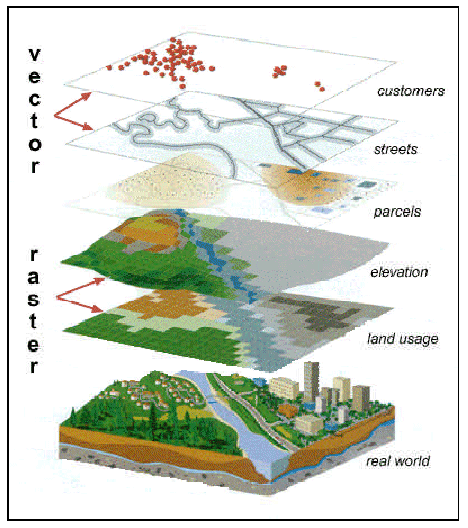 GIS operates on many levels and over the past decade has become an essential tool for most urban and resource planning and management organizations. On the most basic level, GIS can be used for simple digital cartography, to create various types of maps.
GIS operates on many levels and over the past decade has become an essential tool for most urban and resource planning and management organizations. On the most basic level, GIS can be used for simple digital cartography, to create various types of maps.
However the real power of GIS is through its abilities to use both spatial and statistical methods to analyze attribute and geographic information together. The end result of such an analysis can be vast amounts of derivative information, interpolated information or prioritized information.
Geographic information systems commonly known as GIS has become a rapidly growing technological field that allows
Geomatics Specialists to solve and model real world situations by incorporating digital spatial and associated tabular data. It is often defined as a comprehensive computerized information system made up of hardware, specialized software, spatial data and people to help manipulate, analyze and present the information used for storing, manipulating and analyzing spatially indexed information.
GIS technology can be used for scientific investigations, resource and utilities management, modeling, assessments, development planning, cartography and route planning and many other applications.. Some of these and other aspects of the GIS field are currently covered on this web site including projects related to spatial database modeling, Geostatistical spatial modeling, mobile mapping, cartography, and interactive web mapping.
Below are some examples of GIS from a few of the many GIS based projects that I have been involved with over the past few years. The links are to PDF versions of papers, presentations and or manuals related to GIS, I have many more, if anybody is interested in a particular topic then feel free to let me know, as I may have a document available related to that topic.
.
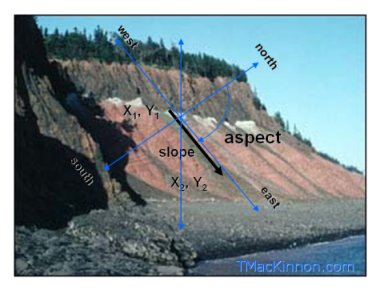
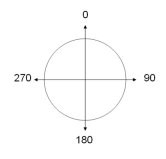 In digital terrain modeling the Aspect of a surface refers to the direction (azimuth) to which a slope face is orientated. The aspect or orientation of a slope can produce very significant influences on it, so it is important to know the aspect of the plane as well as the slope. Together the slope combined with the aspect of the surface can virtually define the surface plane completely in digital terrain modeling.
In digital terrain modeling the Aspect of a surface refers to the direction (azimuth) to which a slope face is orientated. The aspect or orientation of a slope can produce very significant influences on it, so it is important to know the aspect of the plane as well as the slope. Together the slope combined with the aspect of the surface can virtually define the surface plane completely in digital terrain modeling.
Aspect is measured in degrees (similar to a compass bearing) clockwise from magnetic north. A surface with 0 degrees Aspect would represent a north direction, an east facing slope would be 90 degrees, a south facing slope would be 180 degrees and a west facing slope would be 270 degrees.
The example shown to the left (for larger image click here) is a raster aspect model of Lismore, Nova Scotia was derived from a digital elevation model (DEM) calculated using PCI Geomatica remote sensing software. It is represented with a grey scale color ramp and helps to indicate what direction slope faces are orientated.
The image above is of an actual bedrock cliff with some technical information embedded onto the image to help better understand slope and aspect relationships. The black arrow represents the slope or the measured angle that the rock is dipping towards.
The aspect is the orientation that the arrow (slope) is pointing with respect to North, therefore the aspect for this slope would be in an easterly direction and often represented by 90 degrees. The blue arrows represent the X, Y and Z dimensions that the combination of both the slope and aspect would use to represent the terrain features.
The image below is an Aspect Model that I derived from a digital elevation model (DEM) of Lismore, Nova Scotia. The aspect values of the slopes of the DEM are represented in the model by a 0-255 grey scale color ramp. Click here to learn a little more about Aspect Models and how the image below was created.
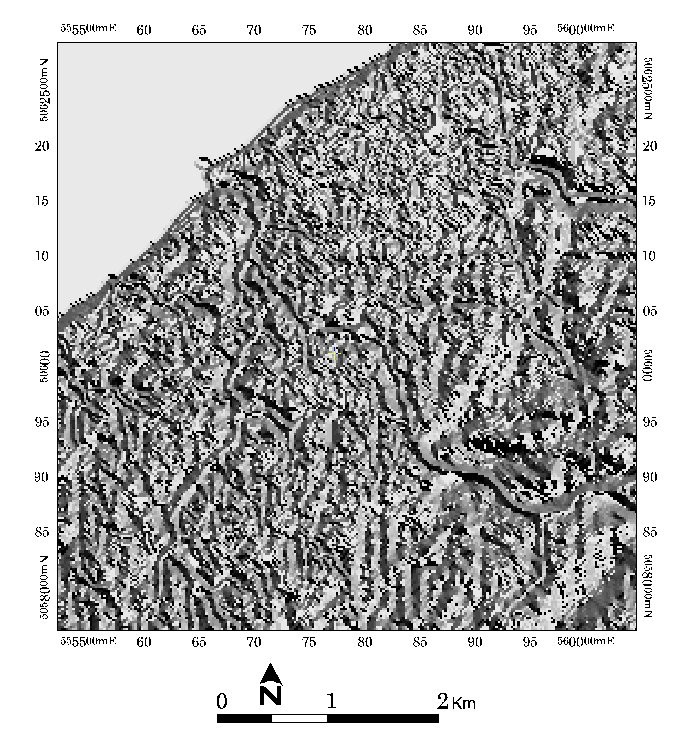
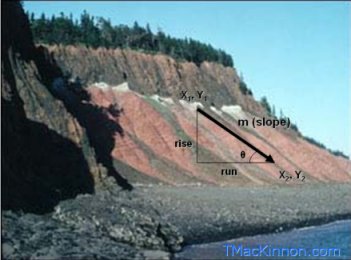
The slope or the gradient of a straight line within a Cartesian coordinate system is known as the measure of how steep a line is relative to the horizontal axis.
In calculations; it is generally represented by the letter m, and defined as the change in the Y coordinate divided by the corresponding change in the X coordinate, between two distinct points on the line (X1, Y1 and X2, Y2). Since the Y axis is vertical and the X axis is horizontal by convention, slope is often referred to as the rise over the run or the change in the vertical coordinates, divided by the change in the horizontal coordinates.
Basically, the larger the slope value, the steeper the line is. A horizontal line has a slope of 0, a 45 degree line has a slope of 1, and the slope of a vertical line is typically undefined. In trigonometry two lines are considered to be parallel if and only if their slopes are equal or if they both are vertical and therefore undefined. Two lines are considered to be perpendicular if and only if the product of their slopes is -1 or one has a slope of 0 and the other is vertical and undefined.
There are two common ways to describe slope. One method is to use the angle of the slope in degrees (0 to 90), and the other is to represent the slope as a percentage (0 to 100). Expressing slope as a percent is common but can be confusing because a percent slope can be greater then 100%. A 100% slope is actually only a 45 degree angle due to the fact that the rise and run of a 45 degree angle are equal and when divided always equals 1 and when multiplied by 100 will equal 100%.
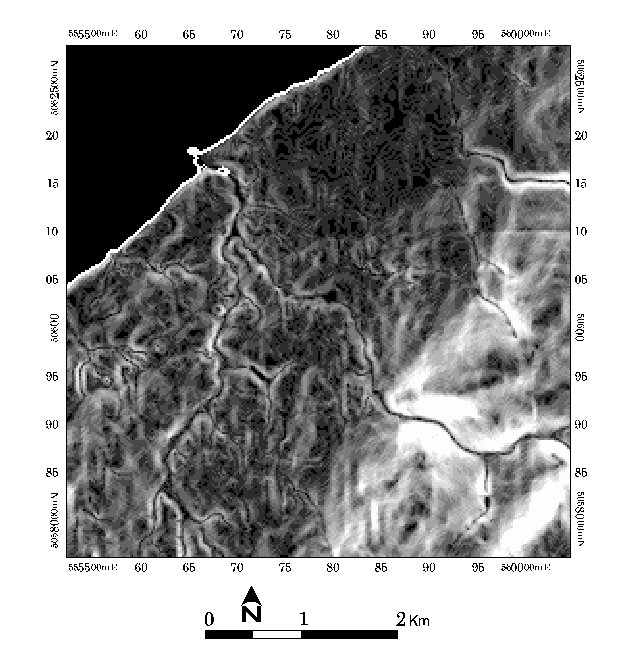 In terrain modeling we generally model an entire surface and not just one line so we need to calculate the slope of a best fit surface plane (which is made of lines). Because the terrain model is usually continuous across the entire surface, it is important to be able to calculate how to represent grid cells (or pixels) when going from one elevation to the next. To do this we generally need to know the aspect or the direction that the surface plane is sloped as well. Together the slope combined with the aspect of the surface can virtually define the surface plane completely.
In terrain modeling we generally model an entire surface and not just one line so we need to calculate the slope of a best fit surface plane (which is made of lines). Because the terrain model is usually continuous across the entire surface, it is important to be able to calculate how to represent grid cells (or pixels) when going from one elevation to the next. To do this we generally need to know the aspect or the direction that the surface plane is sloped as well. Together the slope combined with the aspect of the surface can virtually define the surface plane completely.
In the example shown to the left, a slope map of Lismore, Nova Scotia was derived from a digital elevation model (DEM) calculated using PCI Geomatica remote sensing software. It is represented with a grey scale color ramp therefore the color white represents a 0 slope and the shades of grey increase through to black which represents an undefined slope. The majority of slopes for this map do not exceed 17 degrees (except for vertical slopes) as this is a relative low lying area of Appalachian terrain.
The image above and to the right is of an actual bedrock cliff with some technical information embedded onto it so it may be used to help better understand slope. The black arrow represents the slope or the measured angle that the rock is dipping towards. The slope in the image would be 45 degrees approximately so the slope would be 1 or 100%. The rise and the run of a slope with a 45 degree angle will always equals 1, thus when multiplied by 100 to calculate percent slope will equal always equal 100%.
